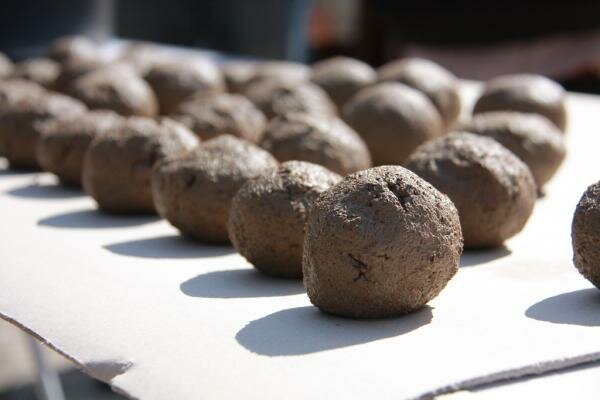Throwing Mud at Flood Water
Thais turn to tossing mud balls in the hope of improving the quality of stagnant water following weeks of flooding.
 Thousands of Thais - with noses pinched and fingers crossed - are tossing mud balls into fetid flood water, in the hope of improving the quality of stagnant water following weeks of flooding.
Thousands of Thais - with noses pinched and fingers crossed - are tossing mud balls into fetid flood water, in the hope of improving the quality of stagnant water following weeks of flooding.
According to the EM Research Organization (EMRO), the Japanese company that invented the balls, they purify water, reducing odour and improving sanitation levels.
The tennis ball-sized treatment has stirred debate in Thailand and prompted calls for controlled studies to see whether it really works on flood water - and whether it could help in future disasters.
"Given the fascination, how it has gained traction here in Thailand, it's really worth it to study it, to understand what its efficacy could be," Maureen Birmingham, the UN's World Health Organization (WHO) representative to Thailand and acting resident coordinator for the UN system, told IRIN.
The Thai government, private companies and relief groups have been distributing for free what is known as EM, or effective micro-organisms, either in liquid or mud-ball form to survivors of flooding that has crippled much of Thailand, with 567 dead and more than 5 million still affected as of 17 November.
"I am surprised how many people come here," said Hisanori Asami, a Bangkok-based representative with EMRO Thailand, working with the Royal Thai Army to distribute the liquid to the public. "Every day, 20,000 litres disappear. People bring 2-litre or 10-litre bottles."
The mud balls are composed of a culture of microbes that includes lactic acid bacteria, yeasts and phototrophic bacteria, as well as molasses, dried dirt and an organic matter such as rice. They work by re-establishing high populations of beneficial micro-organisms and preventing the increase of bad microbes, restoring natural ecosystems, Asami said.
The treatment has been tested in rivers and ponds, but not flood water, according to Asami. In the absence of data, WHO does not have a position on whether people should use mud balls, Birmingham said.
 Does it work?
Does it work?
The question being asked in Thailand - where for years EM has been used for agricultural and waste-management purposes - is whether the mud balls are effective in improving the smell and clarity of flood water in particular, said Pathom Sawanpanyalert, deputy director-general of the Department of Medical Sciences at Thailand's Ministry of Public Health.
"Some people believe that EM might be most effective used on small, enclosed quantities of water, not in a huge volume of water - and probably not in running water," Pathom said. "If it's in a very well-controlled environment, it might be efficacious, but used in a real-life situation, whether it's effective or not, that's a bigger question."
Thai health officials are in talks with WHO and the UN Children's Fund (UNICEF) about a possible independent study on mud balls in the Thai floods, said Claire Quillet, a water, sanitation and hygiene (WASH) specialist with UNICEF.
"Thailand is the best place to study this now," Quillet said. "It doesn't mean we will have a solution right now, but at one stage, it could help countries in other parts of the world."
EM technology, developed in the 1980s by a Japanese professor named Teruo Higa, has multiple uses in the 120 countries where it is distributed. It works as a fertilizer enhancement, a composting additive, and even as an alternative to household cleaning products, according to EMRO.
It has been used in some natural disasters as well, including the 2010 Haiti earthquake and flooding in Poland. In those cases, it mainly served to reduce foul smells, according to case studies on the company's website.
In a crisis such as a flood, the psycho-social benefits of making and using mud balls are worth better understanding as well, Quillet said. Volunteers in Thailand have gathered en masse to combine the liquid with dried dirt to make mud balls, a do-it-yourself process outlined on YouTube.
"The communities that are making them are happy to make them," Quillet said, "and happy to solve the problem that Thailand is facing now."
This article was first published in IRIN.

















